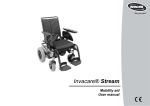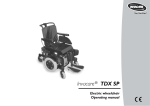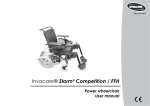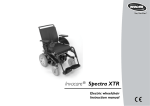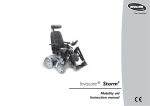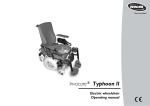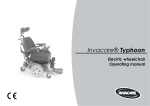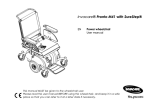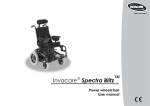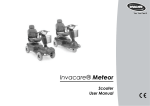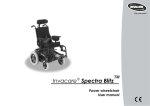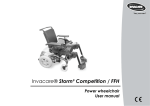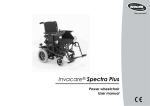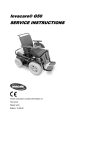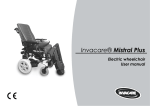Download Invacare® Mirage
Transcript
Yes, You Can.® Invacare® Mirage Electric wheelchair Operating manual How can you get in touch with Invacare®? If you have any questions or need support, please contact your authorised Invacare® Dealer, who has the necessary know-how and equipment plus the special knowledge concerning your Invacare® product, and can offer you all-round satisfactory service. Should you wish to contact Invacare® directly, you can reach us in Europe at the following addresses and phone numbers. 2 Mobitec Mobilitätshilfen GmbH Herzog Odilostrasse 101 A-5310 Mondsee Austria : Fax: @: @: WWW: +43 6232 55 35 0 +43 6232 55 35 4 [email protected] [email protected] www.mobitec-austria.com Invacare® n.v. Autobaan 22 B-8210 Loppem (Brugge) Belgium : Fax: @: WWW: +32 (0)50 83 10 10 +32 (0)50 83 10 11 [email protected] www.invacare.be Mobitec Rehab AG Benkenstraße 260 CH-4108 Witterswil Switzerland : Fax: @: @: WWW: +41 (0)61 48 77 08 0 +41 (0)61 48 77 08 1 [email protected] [email protected] www.mobitec-rehab.ch Invacare Aquatec Alemannenstraße 10 88316 Isny Deutschland Fax @: WWW: +49 (0)75 62 7 00 0 +49 (0)75 62 7 00 66 [email protected] www.invacare-aquatec.de Invacare® A/S Sdr. Ringvej 37 DK-2605 Brøndby Danmark (Kundeservice): Fax (Kundeservice): @: WWW: +45 (0)36 90 00 00 +45 (0)36 90 00 01 [email protected] www.invacare.dk Invacare® SA c/ Areny, s/n Polígon Industrial de Celrà E-17460 Celrà (Girona) ESPAÑA : Fax: @: WWW: +34 (0)972 49 32 00 +34 (0)972 49 32 20 [email protected] www.invacare.es Invacare® Poirier SAS Route de St Roch F-37230 Fondettes France : Fax: @: WWW: +33 (0)247 62 64 66 +33 (0)247 42 12 24 [email protected] www.invacare.fr Invacare® Ltd Pencoed Technology Park Pencoed Bridgend CF35 5HZ United Kingdom (Customer Service): Fax (Customer Service): @: @: WWW: +44 (0)1656 776 222 +44 (0)1656 776 220 [email protected] [email protected] www.invacare.co.uk Invacare Mecc San s.r.l. Via Dei Pini, 62 I - 36016 Thiene (VI) ITALIA : Fax: @: WWW: +39 0445 38 00 59 +39 0445 38 00 34 [email protected] www.invacare.it Invacare Ireland Ltd. Unit 5 Seatown Business Campus Seatown Rd, Swords County Dublin Ireland : Fax: @: WWW: +353 18 10 70 84 +353 18 10 70 85 [email protected] www.invacare.ie Invacare® AS Grensesvingen 9 Postboks 6230 Etterstad N-0603 Oslo Norge (Kundeservice): Fax (Kundeservice): @: WWW: Invacare® B.V. Celsiusstraat 46 NL-6716 BZ Ede Nederland : Fax: @: WWW: +47 (0)22 57 95 00 +47 (0)22 57 95 01 [email protected] www.invacare.no +31 (0)318 69 57 57 +31 (0)318 69 57 58 [email protected] www.invacare.nl 3 Invacare Portugal, Lda Rua Estrada Velha, 949 P-4465-784 Leça do Balio Portugal 4 : : Fax: @: WWW: +351 225 1059 46 +351 225 1059 47 +351 225 1057 39 [email protected] www.invacare.pt Återförsäljare: Invacare® AB Fagerstagatan 9 S-163 91 Spånga Sverige (Kundtjänst): Fax (Kundtjänst): @: @: WWW: +46 (0)8 761 70 90 +46 (0)8 761 81 08 [email protected] [email protected] www.invacare.se Tillverkare: Invacare® Deutschland GmbH Kleiststraße 49 D-32457 Porta Westfalica Deutschland MÖLNDAL : Fax: @: +46 (0)31 86 36 00 +46 (0)31 86 36 06 [email protected] LANDSKRONA : Fax: @: +46 (0)418 285 40 +46 (0)418 180 89 [email protected] OSKARSHAMN : Fax: @: +46 (0)491 101 40 +46 (0)491 101 80 [email protected] Table of Contents Chapter 1 Introduction 1.1 1.2 1.3 1.4 1.5 1.6 2 5 25 26 Using the cane holder .............................................................................................................26 Remove the standard armrest in order to side transfer ......................................................27 Swinging the kerb climber rearward to get in and out of the powerchair .........................28 Driving 5.1 5.2 16 General safety notes ...............................................................................................................16 Safety information with regard to care and maintenance ...................................................20 Safety information on electromagnetic interference ...........................................................21 Safety information on driving and freewheel mode.............................................................22 Safety information on maintenance work and alterations to the wheelchair....................24 Key features Getting in and out of the wheelchair 4.1 4.2 4.3 9 Important symbols in this manual .........................................................................................11 Important symbols found on the vehicle ..............................................................................12 Type classification and permissible use...............................................................................14 Guarantee .................................................................................................................................14 Indications................................................................................................................................15 Life expectancy........................................................................................................................15 Safety notes 2.1 2.2 2.3 2.4 2.5 3 4 Page 30 Before driving for the first time..............................................................................................30 Taking Obstacles.....................................................................................................................31 5 5.3 5.4 6 Pushing the wheelchair in freewheel mode 6.1 7 7.9 7.10 7.11 8.2 6 36 Assembly of the remote..........................................................................................................36 Battery charging display.........................................................................................................38 Adjusting speed.......................................................................................................................39 Using the speedometer...........................................................................................................39 “5 Speed” and “VSP” modes .................................................................................................40 Status display ..........................................................................................................................41 Activate/de-activate the immobiliser .....................................................................................41 Using the remote to control the wheelchair .........................................................................42 7.8.1 How a wheelchair with "Indirect Steering" reacts to joystick movements.....................43 7.8.2 Operating the electric adjustment options ....................................................................44 Control unit for an accompanying person (option) .............................................................45 7.9.1 Layout of the remote.....................................................................................................45 7.9.2 Operating the electric adjustment options ....................................................................46 Error diagnosis ........................................................................................................................47 Error Codes and Diagnostic Codes.......................................................................................48 Adjusting the wheelchair to the user's seating posture 8.1 35 Disengaging Motors ................................................................................................................35 The Shark II Remote 7.1 7.2 7.3 7.4 7.5 7.6 7.7 7.8 8 Driving up and down gradients..............................................................................................33 Parking and stationary............................................................................................................34 5.4.1 Activating and deactivating the manual wheel lock ......................................................34 50 Adjusting the armrests and the control panel......................................................................50 8.1.1 Adapting the control panel to the length of the user’s arm ...........................................50 8.1.2 Setting the height of the remote ...................................................................................51 8.1.3 Setting the height of the armrests.................................................................................52 8.1.4 Adjusting the width of the armrests ..............................................................................53 Adjusting the backrest............................................................................................................56 8.3 8.4 8.5 9 8.2.1 Gas spring angle adjustment........................................................................................56 8.2.2 Manual angle adjustment..............................................................................................57 8.2.3 Adjusting the tension adjustable backrest upholstery ..................................................58 Postural belts ...........................................................................................................................59 8.3.1 Types of postural belts..................................................................................................59 8.3.2 Adjusting the postural belt correctly..............................................................................60 Headrest ...................................................................................................................................61 Adjusting and removing the tray ...........................................................................................62 8.5.1 Laterally adjusting the tray............................................................................................62 8.5.2 Adjusting the depth of the tray / removing the tray.......................................................63 8.5.3 Swinging the tray away to the side ...............................................................................63 Adjusting footrests and legrests 9.1 9.2 Standard legrests ....................................................................................................................65 9.1.1 Swivelling the footrest outward and/or removing..........................................................65 9.1.1.1 Adjusting the length .................................................................................................67 9.1.1.2 Adjusting the length .................................................................................................69 Manually height-adjustable legrest .......................................................................................70 9.2.1 Swivelling the footrest outward and/or removing..........................................................70 9.2.2 Adjusting the angle .......................................................................................................71 9.2.3 Adjusting legrest length ................................................................................................72 9.2.4 Adjusting the calf support depth ...................................................................................73 9.2.5 Adjusting the calf support height ..................................................................................74 9.2.6 Adjusting the angle and depth adjustable foot plate.....................................................75 10 Electrical system 10.1 10.2 65 76 Electronics protection system ...............................................................................................76 10.1.1 The main circuit breakers .............................................................................................77 Batteries ...................................................................................................................................78 10.2.1 What you need to know about batteries .......................................................................78 10.2.2 Charging the batteries ..................................................................................................80 7 10.2.3 Removing and fitting batteries ......................................................................................82 10.2.3.1 Removing the batteries............................................................................................83 10.2.3.2 How to handle damaged batteries correctly ............................................................87 11 Care and maintenance 12 Maintenance- and repair work 12.1 Repairing a flat tyre .................................................................................................................91 12.1.1 Repairing a flat tyre at the back (tyre type 3.00-8") ......................................................92 13 Transport 13.1 13.2 13.3 13.4 14 15 16 17 8 88 91 95 Transferring the wheelchair to a vehicle...............................................................................96 Securing the wheelchair for transport without passengers ...............................................97 Use of the wheelchair as a seat in a vehicle.........................................................................98 13.3.1 How the wheelchair is anchored in a vehicle for use as a vehicle seat .....................100 13.3.2 How the user is secured within the wheelchair...........................................................102 Dismantling the wheelchair for transport ...........................................................................106 13.4.1 Removing legrests ......................................................................................................107 13.4.2 Removing the kerb climber .........................................................................................107 13.4.3 Removing batteries.....................................................................................................109 13.4.4 Removing backrest frame cross strut .........................................................................111 13.4.5 Folding the wheelchair................................................................................................112 13.4.6 Reassembling the wheelchair.....................................................................................114 Refurbishment Disposal Technical specifications Inspections Performed 115 116 117 120 1 Introduction Dear user, First we would like to thank you for purchasing our product! We hope that you will have a great deal of pleasure with your new power wheelchair. This operating manual contains important information and notes about: • Safety • Operation • Care and maintenance Please take care to read the operating manual thoroughly before starting out on your first journey. This wheelchair has been constructed for a large circle of users with different requirements. The decision whether the model is suitable for the user may only be taken by medical specialists with appropriate expertise. Invacare® or their statutory representatives can accept no liability in cases in which the wheelchair has not been adapted to suit the users’ handicaps. Some maintenance and settings can be performed by the user or his/hers attendants. Certain adjustments do however require technical training and may only be carried out by your Invacare® specialist dealer. Damages and errors caused by nonobservance of the operating manual or as a result of incorrect maintenance are excluded from all guarantees. 9 This manual contains copyrighted information. This manual may not be reproduced or reprinted either partly or completely without previous written consent from Invacare® or its statutory representatives. We reserve the right to make any necessary alterations on the grounds of technical improvements. 10 1.1 Important symbols in this manual WARNING! This symbol warns you of danger! • Always follow these instructions to avoid injury to the user or damage to the product! EXPLOSION HAZARD! This symbol warns you of an explosion hazard, which, for example, can be caused by excessive tyre pressure in a pneumatic tyre! • Always follow the instructions to avoid injury to the user or damage to the product! BURN HAZARD! This symbol warns you of burns due, for example, to leaking battery acid! • Always follow the instructions to avoid injury to the user or damage to the product! NOTE: This symbol identifies general information which is intended to simplify working with your product and which refers to special functions. Requirements: • This symbol identifies a list of various tools, components and items which you will need in order to carry out certain work. READ WELL BEFORE OPERATION! This symbol advises you to read information carefully. 11 1.2 Important symbols found on the vehicle This product has been supplied from an environmentally aware manufacturer that complies with the Waste Electrical and Electronic Equipment (WEEE) Directive 2002/96/CE. This product may contain substances that could be harmful to the environment if disposed of in places (landfills) that are not appropriate according to legislation. • The 'crossed out wheelie bin' symbol is placed on this product to encourage you to recycle wherever possible. • Please be environmentally responsible and recycle this product through your recycling facility at its end of life. This symbol indicates the position of an anchoring point for use with a tie-down system. If the symbol appears on a bright yellow sticker, the anchoring point is suitable for fixation of the wheelchair in a vehicle for use as a vehicle seat. If the symbol appears on a transparent sticker, the anchoring point can only be used to tie down the wheelchair for transport without the occupant seated in it. This wheelchair may be used as a vehicle seat, but only if it is equipped with the headrest that has been approved by Invacare for this purpose! • Please always make sure that the wheelchair is equipped with the headrest available from Invacare before using it as a vehicle seat! 12 This symbol indicates the maximum width to which an armrest may be adjusted. Pulling the armrest out further can cause it to fall out of it's fixation. For further information, see chapter "Adjusting the width of the armrests" on page 53. If the power wheelchair is fitted with a table, it is imperative that it is removed and safely stowed when transporting the wheelchair in a vehicle! 13 1.3 Type classification and permissible use This vehicle was designed for persons whose ability to walk is impaired, but who are still physically and mentally able to operate an electric vehicle. It has been classified according to EN 12184 as a class B mobility product (for indoor and outdoor areas). It is therefore compact and agile enough for indoor areas, but also able to overcome many obstacles in outdoor areas. You can find exact information on speed, turning radius, range, safe climbing ability, maximum obstacle height and permissible operating conditions in chapter "Technical specifications" starting from page 117. Please also pay attention to all safety information in chapter "Safety notes" starting from page 16. The vehicle was successfully tested according to German and international standards as to its safety. It was also tested successfully according to EN60529 IPX4 as to its resistance to spray water, and is therefore well suited for typical middle European weather conditions. When equipped with an appropriate lighting system, the vehicle is suitable for use on public roads. 1.4 Guarantee The terms and conditions of the guarantee are part of the general terms and conditions particular to the individual countries in which this product is sold. 14 1.5 Indications The use of this mobility product is recommended for the following indications: The inability or a greatly restricted ability to walk within the scope of the basic requirement to be able to move within one’s own four walls. The need to leave the dwelling place in order to get some fresh air during a short walk or to reach those places generally to be found at close distance to the dwelling and where everyday business is carried out. Provision of power wheelchairs for interior and exterior areas is advisable if the use of handoperated wheelchairs is no longer possible on account of the disability, yet proper operation of an electromotive drive unit is still practicable. 1.6 Life expectancy We estimate a life expectancy of five years for this product, provided it is used in strict accordance with the intended use as set out in this document and all maintenance and service requirements are met. The estimated life expectancy can be exceeded if the product is carefully used and properly maintained, and provided technical and scientific advances do not result in technical limitations. The life expectancy can also be considerably reduced by extreme or incorrect usage. The fact that we estimate a life expectancy for this product does not constitute an additional warranty. 15 2 Safety notes READ WELL BEFORE OPERATION! 2.1 General safety notes Danger of injury if mobility device is used in any other way than the purpose described in this manual! • Only ever use the mobility device in accordance with the instructions in this User's Manual (see chapter "Type classification and permissible use" on page 14). • Pay strict attention to the safety information. Danger of injury if the mobility device is driven when ability to operate a vehicle is impaired by medication or alcohol! • Never drive the mobility device under the influence of medication or alcohol. If necessary, the mobility device must be operated by an attendant who is physically and mentally able. Danger of damage or injury if mobility device is accidentally set into motion! • Switch the mobility device off before you get in, get out or handle unwieldy objects. • When the drive is disengaged, the brake inside the drive is deactivated. For this reason, pushing the mobility device by an attendant is only recommended on flat surfaces, never on gradients. Never leave your mobility device on a gradient with its motors disengaged. Always re-engage the motors immediately after pushing the mobility device (see chapter "Pushing the wheelchair in freewheel mode" on page 35). 16 Danger of injury if the mobility device is switched off while driving, for example by pressing the On/Off Button or disconnecting a cable, due to it coming to an abrupt, sharp stop! • If you have to brake in an emergency, simply release the joystick which will bring you to a halt. (refer to the joystick operating manual for more information). Danger of injury when transferring mobility device to a vehicle for transport with the occupant seated in it! • It is always better to transfer the mobility device to a vehicle without the occupant seated in it. • If the mobility device needs to be loaded up a ramp together with its driver, ensure that the ramp does not exceed the maximum safe slope (see chapter "Technical specifications" from page 117). • If the mobility device does need to be loaded using a ramp which exceeds the maximum safe slope (see chapter "Technical specifications" from page 117), then you must use a winch. An attendant can safely monitor and assist the loading process. • As an alternative you can use a platform lift. Ensure that the total weight of the mobility device including the user does not exceed the maximum permissible weight for the platform lift or winch if you are using. Danger of injury if maximum permissible load is exceeded! • Do not exceed the maximum permissible load (see chapter "Technical specifications" from page 117). • The mobility device is only designed for use by a single occupant whose maximum weight does not exceed the maximum permissible load of the device. Never use the mobility device to transport more than one person. 17 Danger of injury due to wrong lifting or dropping of heavy components! • When maintaining, servicing or lifting any part of your mobility device, take into account the weight of the individual components especially the batteries. Be sure at all times to adopt the correct lifting posture and ask for assistance if necessary. Danger of falling out of the mobility device. • Do not slide forward on the seat, do not lean forward between your knees, do not lean backwards out over the top of the backrest, for example to reach an object. • If a posture belt is installed, it should be correctly adjusted and used each time you use the mobility device. • When transferring to a different seat, position the mobility device as close as possible to the new seat. Danger of injury by moving parts! • Make sure that no injury is incurred by moving parts of the mobility device, like wheels or one of the Lifter Modules (if fitted), especially when children are around. Danger of fire or breaking down due to electric devices being connected! • Do not connect any electric devices to your mobility device that are not expressly certified by Invacare® for this purpose. Have all electrical installations done by your authorised Invacare® Dealer. Danger of injury and damage to wheelchair if the cross strut that connects the push handles becomes loosened during use, or is removed intentionally! • The cross strut between the push handles stabilizes the folding backrest and must be securely fitted at all times during use! It may only be removed to disassemble and/or fold the wheelchair! 18 19 2.2 Safety information with regard to care and maintenance Danger of accident and loss of guarantee if maintenance is insufficient! • For reasons of safety and in order to avoid accidents which result from unnoticed wear, it is important that this electric mobility product undergoes an inspection once every year under normal operating conditions (see inspection plan contained in service instructions). • Under difficult operating conditions such as daily travel on steep slopes, or in the case of use in medical care cases with frequently changing wheelchair users, it would be expedient to carry out intermediate checks on the brakes, accessories and running gear. • If the mobility product is to be operated on public roads, the vehicle driver is responsible for ensuring that it is in an operationally reliable condition. Inadequate or neglected care and maintenance of the mobility product will result in a limitation of the manufacturer's liability. 20 2.3 Safety information on electromagnetic interference This electric vehicle was successfully tested in accordance with International standards as to its compliance with Electromagnetic Interference (EMI) Regulations. However, electromagnetic fields, such as those generated by radio and television transmitters, and cellular phones, can influence the functions of electric vehicles. Also, the electronics used in our vehicles can generate a low level of electromagnetic interference, which however will remain within the tolerance permitted by law. For these reasons we ask you to please observe the following precautions: WARNING: Danger of malfunction due to electromagnetic interference! • Do not switch on or operate portable transceivers or communication devices (such as radio transceivers or cellular phones) when the vehicle is switched on. • Avoid getting near strong radio and television transmitters. • In case the vehicle should be set in motion unintentionally or the brakes are released, switch it off immediately. • Adding electrical accessories and other components or modifying the vehicle in any way can make it susceptible to electromagnetic interference. Keep in mind that there is no sure way to determine the effect such modifications will have on the overall immunity of the electronic system. • Report all occurrences of unintentional movement of the vehicle, or release of the electric brakes to the manufacturer. 21 2.4 Safety information on driving and freewheel mode Danger of injury if the wheelchair tips over! • Inclines and declines can only be travelled up to the maximum safe slope (see chapter "Technical specifications" from page 117). • Always return the backrest of your seat or the seat tilt to an upright position before ascending slopes. We recommend that you position the seat backrest and the seat tilt (if fitted) slightly to the rear before descending slopes. • Only ever drive downhill at a maximum of 2/3 of the top speed. Avoid abrupt braking or accelerating on gradients. • If at all possible, avoid driving on slippery surfaces (such as snow, gravel, ice etc.) where there is a danger of you losing control over the vehicle, especially on a gradient. If driving on such a surface is inevitable, then always drive slowly and with the utmost caution. • Never attempt to overcome an obstacle when on an uphill or downhill gradient. • Never attempt to drive up or down a flight of steps with your wheelchair. • When overcoming obstacles, always observe the maximum obstacle height (see chapter "Technical specifications" from page 117 and information about overcoming obstacles in chapter "Taking Obstacles" from page 31). • Avoid shifting your centre of gravity as well as abrupt joystick movements and changes of direction when the wheelchair is in motion. • Never use the wheelchair to transport more than one person. • Do not exceed the overall maximum permissible load or the maximum load per axle (see chapter "Technical specifications" on page 117). • Note that the wheelchair will brake or accelerate if you change the Driving Mode whilst the wheelchair is in motion. 22 Danger of breaking down in adverse weather conditions, i.e. extreme cold, in an isolated area! • If you are a user with severely limited mobility, we advise that in the case of adverse weather conditions DO NOT attempt a journey without an accompanying attendant! Danger of injury if your foot slides off the footrest and gets caught underneath the wheelchair when it is in motion! • Make sure each time before you drive the wheelchair that your feet are squarely and securely in place on the footplates, and that both legrests are properly locked into place. Danger of injury if you collide with an obstacle when driving through narrow passages such as doorways and entrances! • Drive through narrow passages in the lowest driving mode and with due caution. If your power wheelchair has been fitted with angle-adjustable legrests, there is a danger of personal injury and damage to the wheelchair if you drive the wheelchair with the legrests raised! • To avoid unwanted displacement of the wheelchair centre of gravity to the front (especially when travelling downhill) and in order to avoid damage to the wheelchair, angle-adjustable legrests must always be lowered during normal travelling. CAUTION: Danger of tipping! Anti tip wheels (stabilisers) are only effective on firm ground! They sink in on soft ground such as grass, snow or mud if the electrical vehicle rests itself on them. They lose their effect and the electrical vehicle can tip over. • Only drive with extreme care on soft ground, especially during uphill and downhill journeys. In the process pay increased attention to the tip stability of the electric vehicle. 23 2.5 Safety information on maintenance work and alterations to the wheelchair CAUTION: Danger of tipping over if anti-tip wheels (1) are removed, damaged or adjusted to any position other than the factory setting! • Anti-tip wheels may only ever be removed for disassembling the wheelchair for transport in a vehicle, or for storage! • During use of the wheelchair, the anti-tip wheels must be fitted at all times! Important information about maintenance work tools! Some maintenance work which is described in this manual and can be carried out by the user without problems require the correct tools for proper work. If you do not have the correct tool available we do not recommend that you try to carry out the relevant work. In this case, we urgently recommend that you contact an authorised specialist workshop. 24 3 Key features 1) Push handle cross-strut 2) Locking screw for adjusting armrest height 3) Locking screw for adjusting backrest angle 4) Manual wheel lock (only right side visible in the picture) 5) Disengaging lever (not visible in the picture, located on both sides on each motor) 6) Remote 7) Legrest unlocking lever 25 4 Getting in and out of the wheelchair Important information when side transferring in and out of the wheelchair In order to side transfer it is necessary for the armrest to either be raised or removed completely depending on the model. A skirtguard can be installed as an option in connection with the parallel sliding armrest. This is attached in the same way as the standard armrest and must also be removed when transferring. 4.1 Using the cane holder If your mobility device is fitted with a cane holder, then this can be used to safety transport your walking cane or crutches with you wherever you go. The cane holder consists of a lower plastic holder and an upper Velcro fastener. CAUTION! Injury hazard! Transporting a walking cane or crutches laying loosely across the user's lap or in an otherwise unsecured fashion can pose an injury risk to the user and bystanders! • Always use a cane holder to transport a cane or crutches! • Open the upper Velcro fastener. • Place the bottom end of the cane or crutch in the lower holder. • Use the upper Velcro fastener to secure the cane or crutch in place. 26 4.2 Remove the standard armrest in order to side transfer Removing the armrest: • Loosen star key screw (1) • Remove the side panel from the receptacle 27 4.3 Swinging the kerb climber rearward to get in and out of the powerchair • Pull the handle (1) all the way forward. The kerb climber swings away towards the back and locks in place in this position. • To bring the kerb climber back towards the front, push the handle (1) rearward. Getting into the wheelchair: • Position your wheelchair as close as possible to your seat. This might have to be done by an attendant. • Switch your wheelchair off. • Apply the manual wheel lock of your wheelchair (if existing). • Detach the skirt guard of your wheelchair or swivel it up. • Now slide into the wheelchair. 28 Getting out of the wheelchair: • Drive your wheelchair as close as possible to your seat. • Switch your wheelchair off. • Apply the manual wheel lock of your wheelchair (if existing). • Detach the skirt guard of your wheelchair or swivel it up. • Now slide onto your new seat. NOTE: If you do not have sufficient muscle strength, you should ask other persons for help. Use a sliding board, if possible. 29 5 Driving NOTE The maximum load capacity that is stated in the technical data only states that the system is designed for this mass in total. However, this does not mean that one can sit a person with this body weight in the wheelchair without restrictions. Attention must be paid to the body proportions, such as height, weight distribution, abdominal girth, leg and calf girth and seat depth. These factors have a strong influence on driving features such as tilt stability and traction. The permissible axle loads in particular must be adhered to (see chapter "Technical specifications" as from page 117)! It may possibly be necessary to carry out adaptations to the seat system. 5.1 Before driving for the first time... Before you take your first trip, you should familiarise yourself well with the operation of the vehicle and with all operating elements. Take your time to test all functions and driving modes. NOTE: If installed, make sure to properly adjust and use the postural belt each time you use the wheelchair. Sitting Comfortably = Driving Safely Before each trip, make sure that: You are within easy reach of all operating controls. 30 • The battery charge is sufficient for the distance intended to be covered. • The postural belt (if installed) is in perfect order. 5.2 Taking Obstacles Your wheelchair can overcome obstacles and kerbs with the following heights. • • Without kerb climber: With kerb climber: 60 mm 100 mm Information about the kerb climber! A kerb climber is a mechanism which enables the electric wheelchair to overcome obstacles which would normally not be possible due to their height. The way in which an obstacle should be approached (at right angles and slowly) is the same whether your wheelchair is fitted with a kerb climber or not. CAUTION: Danger of Tipping Over! • Never approach obstacles at an angle but at 90 degrees as shown below. • Put your backrest into an upright position before climbing an obstacle. 31 Driving up over an obstacle Correct • Approach the kerb or obstacle slowly head-on. Shortly before the front wheels or kerb-lifter touch the obstacle, increase the speed and reduce only after also the rear wheels have climbed the obstacle. Driving down off of an obstacle • Approach the kerb or obstacle slowly head-on. Before the front wheels touch the obstacle, reduce the speed and keep it until also the rear wheels have climbed the obstacle. 32 Incorrect 5.3 Driving up and down gradients For information concerning the maximum safe slope, please see chapter "Technical specifications" starting on page 117. WARNING: Danger of tipping over! • Only ever drive downhill at a maximum of 2/3 of the top speed. Avoid sudden changes of direction or abrupt braking when driving on slopes. • Always return the backrest of your seat or the seat tilt (if adjustable seat tilt is available) to an upright position before ascending slopes. We recommend that you position the seat backrest or the seat tilt slightly to the rear before descending slopes. • Always lower the lifter (if fitted) to its lowest position before ascending or descending a slope. • Never attempt to ascend or descend a slope on slippery surfaces or where there is a danger of skidding (such as wet pavement, ice etc). • Avoid trying to get out of the vehicle on an incline or a gradient. • Always drive straight in the direction the road or path you are on goes, rather than attempting to zigzag. • Never attempt to turn around on an incline or a slope. 33 5.4 Parking and stationary When parking your vehicle or if your vehicle is stationary for a prolonged period: • Switch the vehicle's power system off (ON-/OFF key). • Activate your anti-theft lock, if existing. 5.4.1 Activating and deactivating the manual wheel lock The manual wheel locks are located on the left and right sides above the wheels. • Pull the lever (1) upwards and backwards till it audibly locks in place. The manual wheel lock is activated. • To release the wheel lock, push the lever (1) completely forward and downward again. 34 6 Pushing the wheelchair in freewheel mode The motors of the wheelchair are equipped with automatic brakes, preventing that the wheelchair starts rolling out of control when the joystick box is switched off. When pushing the wheelchair manually whilst freewheeling, the magnetic brakes must be disengaged. 6.1 Disengaging Motors Danger of the vehicle running away! • When the motors are disengaged (for push operation whilst freewheeling), the electromagnetic motor brakes are deactivated! When the vehicle is parked, the levers for engaging and disengaging the motors must without fail be locked firmly into the "DRIVE" position (electromagnetic motor brakes activated)! The disengaging levers for the motors are located at the rear on the motor. Disengaging motors: • Switch off remote. • Rotate the engaging lever (1) to the side (position B). The motors are now disengaged. Re-engaging motors • Rotate the engaging lever (1) to the rear (position A). The motors are now re-engaged. 35 7 The Shark II Remote 7.1 Assembly of the remote Top side (standard) 1) 2) 3) 4) 5) 6) 7) 8) 9) 10) 36 Battery charging display ON/OFF button Activate / connect through / deactivate adjusting mode Reduce travel speed Travel speed display Horn Increase travel speed LED for “control unit activated for accompanying person“ Status display Joystick Top side (including light option) 11) 12) 13) 14) 15) Warning indicator Left hand indicator Light Right hand indicator LED for “light activated“ Lower side 1) Combined charging socket / programming socket 37 7.2 Battery charging display • All diodes illuminated: full range! • Only the yellow and red diodes are illuminated: Reduced range! Charge batteries before a longer trip! • Only the red diodes are illuminated: Very low range! Charge batteries as soon as possible! • Only one red diode flashing: Battery on reserve = Charge batteries immediately! Battery charging display INFORMATION Protection against total discharge: after a certain journey time with the battery on reserve the electronic system will automatically shut down actuation and the wheelchair will come to a stop. Total discharge reduces the service life of the batteries considerably. PLEASE NOTE: Danger of battery destruction! After a certain journey time with the battery on reserve the electronic system will automatically shut down actuation and the wheelchair will come to a stop. By waiting a few minutes the batteries can ’recover’ to such a degree that the electronic system can be switched on again. Short continuation of the journey is possible until the wheelchair comes to a stop again. If this procedure is repeated several times the batteries will be destroyed! • Please always ensure that the batteries are charged sufficiently for the planned journey. • If possible, do not drive until the batteries are empty. 38 7.3 Adjusting speed The user can adjust the chair’s top speed to suit their preferences and environment. The currently selected top speed is shown on the Speedometer and can be adjusted using the “Increase Speed” (2) and “Reduce Speed” (1) buttons. 7.4 Using the speedometer Each of the speedometer’s 6 large LEDs typically represent 0%, 20%, 40%, 60%, 80% and 100% of the chair’s maximum speed. The Speedometer is used to gauge the relative speed of the chair in comparison to the maximum speed possible. The right-most LED indicates current maximum speed, which can be adjusted using the Increase (Decrease) Speed button. If the bottom, left-most GREEN LED is flashing SHARK is in SPEED LIMIT mode, which limits the drive speed to a preprogrammed value, typically when a seat is raised or tilted and driving too fast may be dangerous. 39 7.5 “5 Speed” and “VSP” modes Shark II supports 2 modes of top speed adjustment – “5 Speed” and “VSP” modes. In the “5 Speed” mode pressing the Increase Speed and Decrease Speed buttons steps between one of the 5 top speeds 20% to 100%. In the “VSP” mode a quick single press of the Increase Speed and Decrease Speed buttons also steps between one of the 5 speeds 20% to 100%. However, pressing and holding the Increase Speed (Decrease Speed) Button ramps the top Speed up (down) in fine steps, allowing practically any top speed to be selected. This can be particularly useful for matching the chair speed to the walking speed of an accompanying pedestrian. VSP is an extremely powerful feature, allowing both fast stepping between fixed top speeds by using quick presses or finer control using long presses. The VSP feature can be enabled or disabled. Users can toggle between the “VSP” and “5 Speed” Modes by holding down both the Increase Speed and Decrease Speed Buttons for approximately 2 seconds while the unit is powered up. The control unit will beep when the mode has been changed. 40 7.6 Status display The status display serves to display error messages. For error codes see chapter "Error Codes and Diagnostic Codes" on page 48. 7.7 Activate/de-activate the immobiliser Activate the immobiliser Activate • Whilst the remote is switched on, press and hold the ON/OFF button (1) for 4 seconds. The remote will switch off immediately. After 4 seconds the battery charging display will illuminate briefly and the horn will be heard twice. The immobiliser is activated. De-activate the immobiliser Deactivate • Whilst the immobiliser is activated, switch on the remote using the ON/OFF button (1). The diodes of the battery charging display will illuminate briefly once from left to right. A slow countdown will then be displayed from right to left. • Press the horn button (2) twice before the countdown is completed. You have about 10 seconds to do this. The immobiliser is deactivated. 41 7.8 Using the remote to control the wheelchair • Switch on the remote (ON/OFF button). The displays on the remote will illuminate. The wheelchair is ready to start. • Set the travel speed (buttons for adjusting travel speed - see section on "Assembly of the remote" on page 36). Can the electronic system programming be adapted? The electronic controller is programmed with standard values during manufacture. Your Invacare® dealer can carry out programming tailored to fit your requirements. WARNING: Any alteration to the drive programme can influence vehicle handling and the tipping stability of the electric vehicle! • Alterations to the drive programme may only be carried out by trained Invacare® dealers! • Invacare® supplies all electric vehicles from the factory with a standard drive programme. Invacare® can only assume a warranty for the safe vehicle handling of the electric vehicle – in particular tipping stability - for this standard drive programme! Will the wheelchair not drive after switching on? Check the drive-away lock (see chapter "Activate/de-activate the immobiliser " on page 41) and the status bar indicator (see chapter "Battery charging display" on page 38.). 42 7.8.1 How a wheelchair with "Indirect Steering" reacts to joystick movements. "Indirect Steering" occurs by individually applying power to the drive wheels, and is found on wheelchairs with front, rear and middle wheel drive. Travel direction The further the joystick is moved in a particular direction, the more dynamically the wheelchair reacts. Note: To brake quickly, simply let go of the joystick. It will then automatically return to the middle position. The wheelchair will brake. 43 7.8.2 Operating the electric adjustment options Electric adjustment options are operated using the joystick. • Press the adjustment mode button once in order to activate the first adjustment option. Press the adjustment mode button twice in order to activate the second adjustment option. • Move the joystick to the left or right = change adjustment option (B). • Move the joystick forward or backward = operate selected adjustment option (A). How far the joystick is moved in any direction determines the motion speed of the actuator. • Press the adjustment mode button in order to return to drive mode. 44 7.9 Control unit for an accompanying person (option) The control unit for an accompanying person enables the control of the wheelchair to be handled by an accompanying person. 7.9.1 Layout of the remote 1) 2) 3) 4) Joystick Change over control unit to accompanying person/occupant Activate/connect through/deactive adjustment mode Set travel speed 45 7.9.2 Operating the electric adjustment options Electric adjustment options are operated by means of the joystick. The control unit must be switched over to ’accompanying person’ for the adjustment options to be operated via the control unit for the accompanying person. • Press the adjustment mode button. Adjustment mode is activated. • Move the joystick forward or backward = Operate adjustment option (A). • Move the joystick to the left or right = Change adjustment option (B). • Press the adjustment mode button again to return to drive mode. 46 7.10 Error diagnosis If the electronic system shows a failure, please use the following guide to locate the fault. NOTE: Ensure that the drive electronics system is switched on before starting any diagnosis. If the status display is OFF: Check whether the drive electronics system is SWITCHED ON. Check whether all cables are correctly connected. Ensure that the batteries are not discharged. If the battery charge display diodes are FLASHING: Count the number of flashes and then proceed to the next section. 47 7.11 Error Codes and Diagnostic Codes FLASH CODE 1 FAULT EFFECT User error or drive Stops driving motors overloaded Comments • • 2 Battery error Stops driving 3 Fault on left-hand motor (M2) Fault on right-hand motor (M1) Error on left-hand (M2) wheel lock Error on right-hand (M1) wheel lock Stops driving 4 5 6 48 Stops driving Stops driving Stops driving • • • • • • • • • • • Ensure that the joystick is in the neutral central position (simply release the joystick) and switch on again. Drive motors overloaded. Shut electronics down and then switch on again. If the driving power is still reduced, wait a few minutes. Check battery and supply cable. Charge batteries. If you switch the wheelchair off for a few minutes, the batteries can often recharge to such an extent that a short run is still possible. However, you should only do this in an emergency, as this causes the batteries to discharge excessively. Replace batteries Check motor cable and connecting plugs. Check motor. Check motor cable and connecting plugs. Check motor. Check cable and connecting plugs. Check brake. Check cable and connecting plugs. Check brake. FLASH CODE 7 FAULT EFFECT Error in Shark remote Stops driving • 8 Error in Shark power module Stops driving • • 9 Communication error in Shark system Unknown error Stops driving • • 10 11 Incompatible remote Varying Stops driving Comments • • • • Check remote bus cable and all connecting plugs. Replace remote. Check all cables and connecting plugs in the Shark system. Replace power module Check all cables and connecting plugs in the Shark system. Replace remote. Check all cables and connecting plugs. Talk to your dealer. The wrong remote type is connected. Ensure that the power module type code matches the remote type code. 49 8 Adjusting the wheelchair to the user's seating posture 8.1 Adjusting the armrests and the control panel 8.1.1 Adapting the control panel to the length of the user’s arm • Release wing nut (1) . • Adjust the remote by pushing it forwards or backwards to the required location. • Retighten the screw. 50 8.1.2 Setting the height of the remote • Release wing nut (1) . • Adjust remote to required height. • Retighten the wing nuts. 51 8.1.3 Setting the height of the armrests • Loosen the hand screw (1). • Adjust armrest to required height. • Retighten the hand nut. 52 8.1.4 Adjusting the width of the armrests The distance between the armrests can be adjusted by 4 cm on both sides (8 cm in total). WARNING! Danger of serious injury if an armrest falls out of it's fixation tube, due to it having been adjusted to a width that exceeds the specified value! • The width adjustment brackets have small stickers on them with markings and the word "STOP"! The armrest must never be pulled out past the point where the word "STOP" is fully legible! • Always tighten the fixation screws tightly after adjustments are made! Pre-requisites: • 1x 5 mm hexagon socket spanner Where to find the adjustment screws The figure below shows the position of the screws (1) which allows armrest width adjustment (only the right-hand side is shown in the illustration). 53 54 Doing the adjustment • Loosen screw (1) • Adjust armrest to required position. • Retighten the screw. • Repeat this procedure for the second armrest. 55 8.2 Adjusting the backrest 8.2.1 Gas spring angle adjustment The levers (1) for adjusting the backrest are located on the push handles. The inclination can be infinitely adjusted within a range of + 3° and + 38°. Adjusting the backrest: • Pull both levers (1) upwards. • Adjust backrest by moving it forward or backwards. • Release the lever again. The backrest will engage. 56 8.2.2 Manual angle adjustment The levers (1) for adjusting the backrest are located on the push handles. The inclination can be adjusted to four positions 3°, 13°, 23° and 33°. Adjusting the backrest: • Pull both levers (1) upwards. • Adjust backrest by moving the backrest forward or backwards. • Release the lever again. Move the backrest very slightly forward or backwards till it locks in place. 57 8.2.3 Adjusting the tension adjustable backrest upholstery • Remove the backrest cushion (attached with Velcro strips) by pulling it up and off to access the adjustment straps. • Adjust the tension of the individual straps as desired. • Replace the backrest cushion. 58 8.3 Postural belts A postural belt is an option which can either be fixed to the wheelchair ex-works or can be retrofitted by your specialist dealer. If your wheelchair is fitted with a postural belt, your specialist dealer will have informed you about fitting and usage. The postural belt is used to help the wheelchair user keep an optimum sitting position. Correct use of the belt assists the user in sitting securely, comfortably and well-positioned in the wheelchair, especially for such users who do not have such a good sense of balance while sitting. NOTE: We recommend using the postural belt whenever the wheelchair is used. The belt should be tight enough to ensure that you are sitting comfortably and that your body is in the correct sitting position. 8.3.1 Types of postural belts Your wheelchair can be fitted with the following postural belt types ex-works. If your wheelchair has been fitted with a different belt to those listed below, please ensure that you have received the manufacturer's documentation with regard to correct fitting and use. Belt with metal buckle, adjustable one side Belt can only be adjusted on one side which can result in the buckle not sitting centrally. 59 Belt with metal buckle, adjustable both sides Belt can be adjusted on both sides. This means that the buckle can be centrally positioned. 8.3.2 Adjusting the postural belt correctly • Ensure that you are sitting correctly, which means that you are sitting right at the back of the seat, your pelvis is positioned erect and as symmetrically as possible, not to the front, to the side or at one edge of the seat. • Position the postural belt so that your hipbones can be easily felt above the belt. • Adjust the belt length using one of the adjustment aids described above. The belt should be adjusted so that you can fit a flat hand between the belt and your body. • The buckle should be positioned as centrally as possible. In doing so, please carry out adjustments on both sides as much as possible. • Please check your belt every week to ensure that it is still in good working condition; to ensure it has no damage or wear, and that it is fixed properly to the wheelchair. If the belt is only fastened with a bolted connection, ensure that the connection has not loosened or undone. You can find more information about maintenance work on belts in the service manual, which is available from Invacare®. 60 8.4 Headrest CAUTION: Injury hazard during use of the mobility aid as a vehicle seat if a headrest is wrongly adjusted or not installed! This can cause the neck to be hyperextended during collisions! • A headrest must be installed! The headrest optionally supplied for this mobility device by Invacare® is perfectly suitable for use during transport. • The headrest must be adjusted to the user's ear height. • Loosen the clamping levers (1) to adjust the height of the headrest. • Adjust the headrest to the required height. • Retighten clamping levers. • Loosen the clamping lever (2) to adjust the angle of the headrest. • Adjust to the required position. • Retighten clamping lever. 61 8.5 Adjusting and removing the tray CAUTION: Injury hazard or material damage if a power wheelchair which is fitted with a table is transported in a vehicle! • If a table is fitted, always remove it before transporting the wheelchair. 8.5.1 Laterally adjusting the tray • Loosen the wing-screw (1). • Adjust the tray towards the left or right. • Re-tighten wing-screw. 62 8.5.2 Adjusting the depth of the tray / removing the tray • Loosen the wing-screw (1). • Adjust the table to the desired depth (or remove it entirely). • Re-tighten the screw. 8.5.3 Swinging the tray away to the side The tray can be swivelled up and away to the side to allow the user to get in and out of the mobility device CAUTION! Risk of injury! When the tray is raised it does not lock in place in this position! • Do not tilt the tray up and leave it leaning in this position. • Never attempt to drive with the tray tilted up. • Always lower the tray in a controlled manner. 63 The tray can be swivelled upwards and pushed to the side as illustrated to enable getting on and off. 64 9 Adjusting footrests and legrests 9.1 Standard legrests 9.1.1 Swivelling the footrest outward and/or removing The small release lever is to be found in the upper part of the legrest (1). When the legrest is released it can be swivelled inward or outward to facilitate access and also be removed completely. 65 • Push the release lever inward or outward. The legrest is released. • Swivel the legrest inward or outward. • To remove the legrest simply pull upward. 66 9.1.1.1 Adjusting the length Pre-requisites: • 1x 5 mm hexagon socket spanner • Loosen the screw (1) using the Allen key, but do not remove completely. • Set the legrest to the desired length. • Re-tighten the screw. 67 The small release lever is to be found in the upper part of the legrest (1). When the legrest is released it can be swivelled inward or outward to facilitate access and also be removed completely. • Push the release lever inward or outward. The legrest is released. • Swivel the legrest inward or outward. • To remove the legrest simply pull upward. 68 9.1.1.2 Adjusting the length Pre-requisites: • 1x 5 mm hexagon socket spanner • Loosen the screw (1) using the Allen key, but do not remove completely. • Set the legrest to the desired length. • Re-tighten the screw. 69 9.2 Manually height-adjustable legrest 9.2.1 Swivelling the footrest outward and/or removing The unlocking knob is located on the top section of the legrests. When the legrest is unlocked, it can be swivelled to the inside or outside to facilitate getting in, or can be completely removed. • Press the unlocking knob (1) and remove the legrests upwards. 70 9.2.2 Adjusting the angle PLEASE NOTE: Danger of crushing! • Do not reach inside the swivelling range of the legrest! PLEASE NOTE: Danger of injury due to incorrect adjustment of the footrests and legrests. • Before and during every journey it is imperative to ensure that neither the legrests nor the steering wheels contact the ground! • Press the unlocking lever (1) down. Adjust the legrest to the required angle. • Release the unlocking lever. The legrest engages. 71 9.2.3 Adjusting legrest length PLEASE NOTE: Danger of injury due to incorrect adjustment of the footrests and legrests. • Before and during every journey it is imperative to ensure that neither the legrests nor the steering wheels contact the ground! Pre-requisites: • 1x 5 mm hexagon socket spanner • Loosen bolt (1) with the Allen key. • Adjust to required length. • Retighten the screw. 72 9.2.4 Adjusting the calf support depth The calf support has four depth settings. Pre-requisites: • 1x 4 mm Allen key • Swivel the calf support to the front. • Release bolt (1) with the Allen key and remove. • Set the nut on the other side to the required depth. • Adjust the calf support to match the depth of the nut, put the screw back in and tighten. 73 9.2.5 Adjusting the calf support height • Loosen the hand screw (1). • Adjust to required position. • Retighten the wing nuts. 74 9.2.6 Adjusting the angle and depth adjustable foot plate Pre-requisites: • 1x 5 mm Allen key • Use the Allen key to loosen the set screw on the foot plate (1). • Adjust the foot plate to the desired angle or depth. • Re-tighten the screw. 75 10 Electrical system 10.1 Electronics protection system The vehicle's electronics are equipped with an overload-protection system. If the motors are put under considerable strain for a longer period of time (for example, when driving up a steep hill) and especially when the ambient temperature is high, then the electronic system could overheat. In this case the vehicle's power is reduced gradually until it finally comes to a halt. The Status Display shows a corresponding error code (see chapter "Error Codes and Diagnostic Codes" on page 48). By switching the power supply off and back on again, the error code is cancelled and the electronics are switched back on. It will take approximately five minutes until the electronics have cooled down enough for the motors to restore full power again. When the motors are stalled by an insurmountable obstacle, such as a high kerb, and the vehicle driver allows the motors to strain against this hindrance without moving, the electronics will automatically switch off after a maximum of 20 seconds to prevent the motors from being damaged. The Status Display shows a corresponding error code (see chapter "Error Codes and Diagnostic Codes" on page 48). By switching off and back on again, the error code is cancelled and the electronics are switched back on. If the motors are stalled by an insurmountable obstacle, and the vehicle driver allows the motors to strain against this hindrance without moving, but then returns the joystick to a neutral position before the electronics have a chance to register the error, and repeats this a few times, the electronics may not activate the emergency shut-off. In this case, one or both of the circuit breakers on the battery boxes may overheat and pop out. See the next section for information on reactivating them. 76 10.1.1 The main circuit breakers NOTE The circuit breakers are located on the left sides of the battery boxes. If the electrical system draws too much power for a period of time, one or both may overheat and pop out. To reactivate the electrical system, wait a few minutes until they have cooled down a bit, then push them back in. The illustration at right shows the positions of the circuit breakers (1) on the battery boxes. 77 10.2 Batteries 10.2.1 What you need to know about batteries Power is supplied by two 12 V batteries. The batteries are maintenance-free and only need regular charging. New batteries should always be fully charged once before their first use. New batteries will be at their full capacity after having run through approx. 10 - 20 charging cycles. How fast the batteries discharge depends on many circumstances, such as ambient temperature, condition of the surface of the road, tyre pressure, weight of the driver, way of driving and utilisation of lighting. 78 NOTE The batteries supplied with your electric vehicle are not hazardous goods. This classification is based on the German GGVS Hazardous Goods Road Transport Ordinances, and the IATA/DGR Hazardous Goods Rail Transport / Air Transport Ordinances. Batteries may be transported without restrictions, whether by road, rail or by air. Individual transport companies have, however, guidelines which can possibly restrict or forbid certain transport procedures. Please ask the transport company regarding each individual case. Pay attention to the Battery Charge Indicator! Make sure to charge the batteries when the Battery Charge Indicator shows that battery charge is low. We recommend charging the batteries after each trip, as well as each night over night. Depending on the level of discharge, it can take up to 12 hours until the batteries are fully charged again. Protect your charger from sources of heat such as heaters and direct sunlight. If the battery charger overheats, charging current will be reduced and the charging process delayed. To avoid damaging the batteries, never allow them to be fully discharged. Do not drive on heavily discharged batteries if it is not absolutely necessary, as this will strain the batteries unduly and shorten their life expectancy. In case your vehicle is not used for a longer period of time, then the batteries must be charged at least once a month to maintain a full charge. Alternatively, the vehicle can stay connected to the charger. The batteries cannot be overcharged with the specified charger. Please use only charging devices in Class 2. This class of chargers may be left unattended during charging. All charging devices which are supplied by Invacare® comply with these requirements. 79 10.2.2 Charging the batteries • Make sure you read and understand the battery charger's User's Manual, if supplied, as well as the safety notes on the front and rear panels of the charger! WARNING: Danger of explosion and destruction of batteries if the wrong battery charger is used! • Only ever use the battery charger supplied with your vehicle, or a charger that has been approved by Invacare®. Danger of electric shock and damage to the battery charger if it is allowed to get wet! • Protect the battery charger from water. • Always charge in a dry environment. Danger of short circuit and electric shock if the battery charger has been damaged! • Do not use the battery charger if it has been dropped or damaged. Danger of fire and electric shock if a damaged extension cable is used! • Only ever use an extension cable if it is absolutely necessary. In case you must use one, make sure it is in good condition. 80 Charging the batteries • Switch off the electric wheelchair at the remote. • Connect the charging device to the remote. The charging socket is to be found on the underside of the remote (1). • Connect the charging device to the mains supply and switch on if necessary. • After charging, first disconnect the charging device from the mains supply, then disconnect the plug connection from the remote. 81 10.2.3 Removing and fitting batteries WARNING: Danger of injury if the batteries are not handled correctly during assembly and maintenance work! • New batteries should be installed by authorised technicians! • Observe the warnings on the batteries! • Take into account the heavy weight of the batteries! • Only ever use the battery type defined in the technical specifications (see "Technical specifications" on page 117)! Danger of fire and burns if battery terminals are short-circuited! • DO NOT short-circuit battery terminals with a tool! WARNING: Corrosion and burns from acid leakage if batteries are damaged! • Remove clothes that have been soiled by acid immediately. After contact with skin: • Immediately wash affected area with lots of water. After contact with eyes: • Immediately rinse eyes under running water for several minutes; consult a physician. 82 10.2.3.1 Removing the batteries CAUTION: Risk of fire and burns if battery poles are bridged! • When replacing the batteries the battery poles MUST NOT come into contact with metal parts of the wheelchair causing bridging. • Be sure to replace the battery pole caps after the batteries have been replaced. WARNING: Risk of fire and burns due to damage to the battery cables! • The battery cables and other cables are positioned in a cable duct above the batteries. The cable duct protects the cables against crushing and other damage. It may not be removed. Requirements: • 1x jaw spanner 11 mm PLEASE NOTE: If your wheelchair is fitted with a lifter the seat unit must be pulled upward in order to access the batteries. This work should be carried out by at least two people. 83 • Open battery fixing strap (buckle). • Remove battery cable connecting plugs on both sides (the figure only shows the right-hand side). 84 • Pull the rear battery box out towards the back. • Open the battery retaining strap velcro fastening. 85 • Pull the battery retaining strap to the side over the edge of the battery box. • Open the battery box. • Pull the battery terminal caps (1) upwards and push them back to allow access to the battery terminals. • Loosen battery terminal clamps with the spanner. • Replace battery. • Re-assembly is done in reverse order. 86 10.2.3.2 How to handle damaged batteries correctly WARNING: Corrosion and burns from acid leakage if batteries are damaged! • Remove clothes that have been soiled by acid immediately. After contact with skin: • Immediately wash affected area with lots of water. After contact with eyes: • Immediately rinse eyes under running water for several minutes; consult a physician. • Always wear safety goggles and appropriate safety clothing when handling damaged batteries. • Place damaged batteries in an acid-resistant receptacle immediately after removing them. • Only ever transport damaged batteries in an appropriate acid-resistant receptacle. • Wash all objects that have come into contact with acid with lots of water. Disposing of dead or damaged batteries correctly Dead or damaged batteries can be given back to your dealer or directly to Invacare®. 87 11 Care and maintenance NOTE: Have your vehicle checked once a year by an authorised Invacare® dealer in order to maintain it's driving safety and roadworthiness. Cleaning the vehicle When cleaning the vehicle, pay attention to the following points: • Only use a damp cloth and gentle detergent. • Do not use any abrasive or scouring liquids. • Do not subject the electronic components to any direct contact with water. • Do not use high-pressure cleaning devices. Disinfection Spray or wipe disinfection using a tested and recognised product is permitted. A list of the current permitted disinfectants is available from the Robert Koch Institute at http://www.rki.de. 88 Monthly Weekly When Delivered Maintenance Jobs Seat and backrest padding: - Check for perfect condition. Side part and armrest: - Are all fastening elements installed? - Can armrests / side parts be removed and installed without too much physical effort? - Are armrests secured in their positions? Legrests: - Do legrests lock into place without any problem (only applies to detachable legrests)? Manually angle adjustable backrest: - Is the ratchet mechanism of the angle adjustment undamaged and in good working order? - Do the different adjustment functions work without any problem? Tyres: - Have tyres checked for specified air pressure (see Technical Specifications). Anti-tip wheels - Check that the anti-tip wheels are undamaged. Castor wheels and forks - Castor wheels must rotate smoothly. - Check fork bearing for play pushing and pulling the wheel back and forth Drive wheels: 89 - Check that the wheel is firmly attached to the axle and has no play, by pushing and pulling it from the side. - Rear wheels must turn without wobbling Electronics / Electrical System: - Check that all plug connections are undamaged and firmly connected. - Have all batteries been fully charged before the daily operation? - Are all electric bulbs of the lighting system (if applicable) in working order? Cleaning: - Clean all parts carefully. Before every trip Before every trip When necessary Have your vehicle inspected and serviced once a year by your authorised dealer. A complete checklist of necessary maintenance work can be found in the Service Manual, which can be obtained from Invacare®. 90 12 Maintenance- and repair work The following are instructions on maintenance and repairs that can be performed by the user. For the specifications of spare parts please see "Technical specifications" on page 117, or consult the Service Manual, available from Invacare® (in this connection please see the addresses and phone numbers in section "How can you get in touch with Invacare®?" on page 2). In case you require assistance, please contact your Invacare® Dealer. 12.1 Repairing a flat tyre WARNING: Danger of damage or injury if the vehicle is accidentally set into motion during repairs! • Switch the power off (ON/OFF Button)! • Engage the motors! • Secure the vehicle against rolling away by placing wedges under the wheels! CAUTION: Risk of damage to the vehicle! Collisions can be caused if shim rings are removed from the drive wheels during installation work! • Shim rings are frequently placed between the drive shaft and the wheel hub to compensate tolerances. Collisions can be caused if these shim rings are removed and not re-installed! Please install all shim rings in exactly the same positions they were in before dismantling. CAUTION: Risk of injury if maintenance and repair work is not carried out in exact accordance with the instructions, including utilizing any special tools specified! • If you do not have access to all the required tools, then you should NOT attempt to perform the work! 91 12.1.1 Repairing a flat tyre at the back (tyre type 3.00-8") Injury hazard! If the wheel has been insufficiently secured during assembly, it can become loosened during driving! • When refitting the drive wheels, tighten the Torx screw that secures the wheel to the hub to a torque of 30 Nm! • Secure all screws using a suitable threadlock (e.g. Loctite 243)! Requirements: • Torque wrench with ... • Allen bit 5 mm • Torx bit T40 • Repair kit for tyre repair or a new inner tube. • Talcum powder • Threadlock Loctite (e.g. Loctite 243) 92 Removing the wheel • Jack the vehicle up and place a block of wood underneath it to prop it up. • Remove the countersunk screw (1) using the Torx bit. • Remove the wheel from the axle. EXPLOSION HAZARD! The wheel will explode if the air pressure is not released from the tyre before disassembling the wheel rim! • Always make sure to completely release the air pressure by pressing the pin in the centre of the valve! Repairing the flat tyre • Remove the valve cap. • Let the air out of the tyre completely by pressing the pin in the centre of the valve in. • Remove the 5 cylinder head screws (back of the wheel, 2). • Remove the rim halves from the tyre. • Remove the inner tube from the tyre. • Repair the inner tube and re-fit, or replace it with a new one. 93 NOTE In case the old inner tube is to be repaired and used again, and it happens to get wet during repair, then it is easier to re-fit it if you powder it lightly with talcum powder. NOTE Re-assembly is done in reverse order. Make sure that the wheel is put back on the same side it was on, and that it runs in the same direction it did before it was removed. • Re-fit the rim halves back into the tyre. • Pump up the tyre a little. • Insert the cylinder head screws in the rim and tighten to 10 Nm. Make sure the inner tube does not get pinched between the rims halves! • Check to make sure that the tyre is squarely in place on the rim. • Pump up the tyre to the recommended tyre pressure. • Check to make sure that the tyre is still squarely and snugly in place on the rim. • Screw the valve cap back on. • Refit the wheel. • Refit the Torx screw using threadlock and tighten to 30 Nm. 94 13 Transport CAUTION: Injury hazard or material damage if a power wheelchair which is fitted with a table is transported in a vehicle! • If a table is fitted, always remove it before transporting the wheelchair. CAUTION: Danger of death or serious injury to the mobility device user and potentially any other nearby occupant of the vehicle, if a mobility device is secured using a 4-point tie-down system available from a third party supplier and the unladen weight of the mobility device exceeds the maximum weight for which the tie-down system is certified! • Make sure the weight of the mobility device does not exceed the weight for which the tiedown system is certified. Consult the tie-down manufacturer's documentation. • If you are unsure how much your mobility device weighs, then you must have it weighed using calibrated scales. 95 13.1 Transferring the wheelchair to a vehicle WARNING: Danger of tipping over, if the wheelchair is transferred to a vehicle using a ramp that exceeds the maximum safe slope, or if the backrest is not in an upright position during transfer! • If the wheelchair has to be transferred to a vehicle using a ramp that exceeds the maximum safe slope (see chapter "Technical specifications" starting on page 117), then a winch must be used. An attendant can then safely oversee and assist the transfer process. • If no winch is installed, then the wheelchair must not be transferred to a vehicle using a ramp that exceeds the maximum safe slope. • Alternatively, a tail lift installed in the vehicle may be used. • Only ever transfer the wheelchair to a vehicle with the backrest in an upright position. Ensure that the total weight of the mobility aid including the user does not exceed the highest permissible weight for the platform lift. • Only ever run the wheelchair with the seat back in the upright position, seat lifter lowered and the seat tilting in the upright position into the transport vehicle (please refer to chapter "Driving up and down gradients" on page 33). 96 13.2 Securing the wheelchair for transport without passengers CAUTION: Injury hazard! • If you are unable to fasten your electric wheelchair securely in a transport vehicle, we recommend that you do not transport it! • Before transporting your wheelchair, make sure the motors are engaged and that the Joystick Box is switched off. • We urgently recommend securing the wheelchair to the floor of the transporting vehicle. 97 13.3 Use of the wheelchair as a seat in a vehicle Please note In order to use a wheelchair as a motor vehicle seat, it needs to be equipped with attachment points to enable anchoring in the motor vehicle. These accessories may be included in the standard scope of wheelchair order and delivery in some countries (UK for example), but may also be obtained from Invacare® as an option in other countries. This power wheelchair complies with the requirements of ISO 7176-19:2001 and may be used as a vehicle seat in connection with an anchoring system that has been checked and approved in accordance with ISO 10542. The wheelchair has undergone a crash test in which it was anchored in the transporting vehicle's direction of travel. Other configurations were not tested. The crash test dummy was secured using pelvic and upper body safety belts. Both types of safety belt should be used in order to minimise the risk of injuries to head or upper body. It is imperative that the wheelchair is inspected by an authorised dealer before being used again after being involved in a crash. Alterations to the wheelchair anchoring points may not be carried out without the manufacturer's permission. 98 Caution: There is a danger of injury if the wheelchair is not properly secured during use as a vehicle seat! • If possible, the user should always leave the wheelchair to use a vehicle seat and the safety belts provided with the vehicle. • The wheelchair should always be anchored facing in the transport vehicle's intended direction of travel. • The wheelchair must always be secured in accordance with the wheelchair and anchoring system manufacturers’ operating manual. • Always remove and secure any accessory parts fixed to the wheelchair such as chin controls or tables. • If your wheelchair is equipped with an angle adjustable backrest, then it must be placed in an upright position. • Fully lower elevated legrests, if fitted. • Fully lower the seat lifter, if fitted. WARNING: Danger of injury exists if a power wheelchair that is not equipped with leakproof batteries is transported in a vehicle! • Only ever use leak-proof batteries! WARNING: Danger of injury or damage to the wheelchair or to the transporting vehicle, if the legrests are in a raised position while the wheelchair is used as a vehicle seat! • Always completely lower height-adjustable legrests, if fitted. 99 13.3.1 How the wheelchair is anchored in a vehicle for use as a vehicle seat The power wheelchair is fitted with four anchoring points, which are labelled with the symbol shown on the right. Snap hooks or belt loops can be used for fixation. • Secure the wheelchair in the front (1) and rear (2) with the anchoring system belts (only left side visible in the picture). The kerb climber does not need to be removed. • Secure the wheelchair by tensioning the belts in accordance with the manufacturer's anchoring system operating manual. 100 101 13.3.2 How the user is secured within the wheelchair CAUTION: There is a danger of injury if the user is not properly secured within the wheelchair! • Even if the wheelchair is fitted with a postural belt, this is no substitute for a proper safety belt which complies with ISO 10542 in the transport vehicle. Always use the safety belt installed in the transport vehicle. • Safety belts must be in contact with the user's body. They must not be held at a distance from the user's body using parts of the wheelchair such as armrests or wheels. Refer to the illustration on page 104. • Safety belts must be pulled as tightly as possible without causing the user discomfort. Refer to the illustration on page 104. • Safety belts must not be positioned while twisted. • Ensure that the third seatbelt anchorage point is not fixed directly to the vehicle floor, but to one of the vehicle uprights. 102 CAUTION: Injury hazard during use of the mobility aid as a vehicle seat if a headrest is wrongly adjusted or not installed! This can cause the neck to be hyperextended during collisions! • A headrest must be installed! The headrest optionally supplied for this mobility device by Invacare® is perfectly suitable for use during transport. • The headrest must be adjusted to the user's ear height. 103 Seat belts may not be held at a distance from the user's body using parts of the wheelchair such as armrests or wheels. 104 The pelvic belt should be positioned in the area between the user's pelvis and thighs so that it is unobstructed and not too loose. The ideal angle of the pelvic belt to the horizontal is between 45° and 75°. The maximum permissible angle is between 30° and 75°. The angle should never be less than 30°! The safety belt installed in the transporting vehicle should be applied as shown in the illustration at right. 1) Centre line of the body 2) Centre of the sternum 105 13.4 Dismantling the wheelchair for transport To dismantle and fold the wheelchair together for transport, please proceed as follows. • Remove legrests. • Remove the kerb climber (available as option and not always fitted). • Remove the battery cable. • Remove the battery case. • Remove the backrest cross strut. • Remove the seat cushion. • Fold the wheelchair together and load it. The wheelchair is reassembled in reverse order to the above sequence. 106 13.4.1 Removing legrests NOTE: Disassembly of the legrests is dependent on their type. For more information about this, please see Chapter Adjusting footrests and legrests on page 65. 13.4.2 Removing the kerb climber The kerb climber is fitted with quick release axles. The quick release axles are fitted with securing balls (1) which prevent the quick release axles sliding out of the mounting. • The securing balls are released by pressing in the unlocking knob (2). This means that the kerb climber can be quickly removed and refitted. 107 Removing the kerb climber • Press the unlocking knobs and pull the quick release axles (1) out of the mountings. • Remove the kerb climber from the mountings. 108 13.4.3 Removing batteries • Open battery fixing strap. • Remove battery cable connecting plugs on both sides (the figure only shows the right-hand side). 109 • Pull the rear battery box out towards the back. 110 13.4.4 Removing backrest frame cross strut Removing the cross strut: • Release the knurled screws on both sides (1) of the cross strut. • Unhook the cross strut at the right-hand knurled screw. 111 13.4.5 Folding the wheelchair 112 Stage 1 Stage 2 Stage 3 Removing the seat cushion (1). There are two locks (1) located right and left under the seat which need to be opened in order to fold the chair together. Press the locking lever (1) inwards and downwards. Stage 4 Stage 5 Open the lock inwards. Repeat the procedure on the other side. Tilt the wheelchair slightly to the side and press it together. Stage 6 113 13.4.6 Reassembling the wheelchair NOTE: Reassembly of the wheelchair takes place in reverse order to disassembly. 114 14 Refurbishment The product is suitable for refurbishment. Actions to be carried out: • Cleaning and disinfection. Please see chapter "Care and maintenance" on page 88. • Inspection according to service plan. Please consult service instructions, available from Invacare®. • Adaptation to the user. Please see chapter "Adjusting the wheelchair to the user's seating posture" on page 50. 115 15 Disposal • The equipment wrapping is potentially recyclable. • The metal parts are used for scrap metal recycling. • The plastic parts are used for plastic recycling. • Electric components and printed circuit boards are disposed of as electronic scrap. • Exhausted or damaged batteries can be returned to your medical equipment supplier or Invacare®. • Disposal must be carried out in accordance with the respective national legal provisions. • Ask your city or district council for details of the local waste management companies. 116 16 Technical specifications Permissible operating and storage conditions Temperature range for operation • -25° … +50 °C according to ISO 7176-9: Temperature range for storage • -40° … +65 °C according to ISO 7176-9: Electrical system Motors Batteries Main fuse Charging device Output current Output voltage Input voltage Operating temperature (surroundings) Storage temperature • • • • 2 x 110 W 2 x 12 V/30 Ah, leakproof/gel 2 x 12 V/40 Ah, leakproof/gel 2x 40 A • • • • 8A±8% 24 V nominal (12 cells) 200 – 250 V nominal -25° ... +50 °C • -40° ... +65 °C Drive wheel tyres Tyre type Tyre pressure • 330 mm (12½" x 2¼") pneumatic or puncture-proof • 2.8 bar Steering wheel tyres Tyre type • 200 x 50 mm pneumatic or solid rubber 117 Steering wheel tyres Tyre pressure Driving characteristics Speed Max. safe slope Max. climbable obstacle height Turning radius Drive range in accordance with ISO 7176 *** Dimensions Total height Drive unit width Total length (incl. standard legrests) Seat height **** Seat width (armrest adjustment range in brackets) Seat depth Backrest height **** Seat cushion thickness Backrest angle • 2.8 bar • • • • • • • • • 940 mm • 530, 570, 610, 680 mm • 1070 mm • 470 mm • 350, 400, 450, 500 mm (80 mm**) • • • • • • Armrest height (standard armrest) • Legrest length • 118 3 km/h 6 km/h 15.8 % (9°) dyn. 60 mm (without kerb climber) 100 mm (with kerb climber) 900 mm 20 km (30 Ah batteries) 25 km (40 Ah batteries) 400, 450, 500 mm 450, 530 mm 50 mm +3° ... +35° (gas spring) +14° (fixed) 3°, 13°, 23°, 33° (manual) 270 ... 340 mm 350 ... 460 mm Dimensions Seat angle • 2° Weight ***** Empty weight (seat width 400 mm) • 64 kg (30 Ah batteries) • 72 kg (40 Ah batteries) Component weights Batteries 30 Ah Batteries 40 Ah • approx. 11 kg per battery • approx. 15 kg per battery Loading Max. load • 120 kg Axle loads Max. front axle load Max. rear axle load • 96 kg • 123 kg * Approximate. ** Width adjustable for side panel adjustment. *** Note: The drive range of an electric wheelchair is strongly influenced by external factors, such as the charging state of the batteries, surrounding temperature, local topography, road surface characteristics, tyre pressure, weight of driver, drive style and use of batteries for lighting, servos etc. **** Measured without seat cushion ***** The actual kerb weight depends on the fittings your mobility aid has been supplied with. Every Invacare® mobility aid is weighed when leaving the works. Please refer to the nameplate for the kerb weight (including batteries) measured. 119 17 Inspections Performed It is confirmed by stamp and signature that all jobs listed in the inspection schedule of the Service and Repair Instructions have been properly performed. The list of the inspection jobs to be performed can be found in the Service Manual which is available through Invacare®. Delivery Inspection 1st Annual Inspection Stamp of authorised Dealer / Date / Signature Stamp of authorised Dealer / Date / Signature Stamp of authorised Dealer / Date / Signature Stamp of authorised Dealer / Date / Signature Stamp of authorised Dealer / Date / Signature Stamp of authorised Dealer / Date / Signature 2nd Annual Inspection 4th Annual Inspection 120 3rd Annual Inspection 5th Annual Inspection 121 English Order No. of this Manual: 1513283.DOC Release Date: 17.05.2010



























































































































